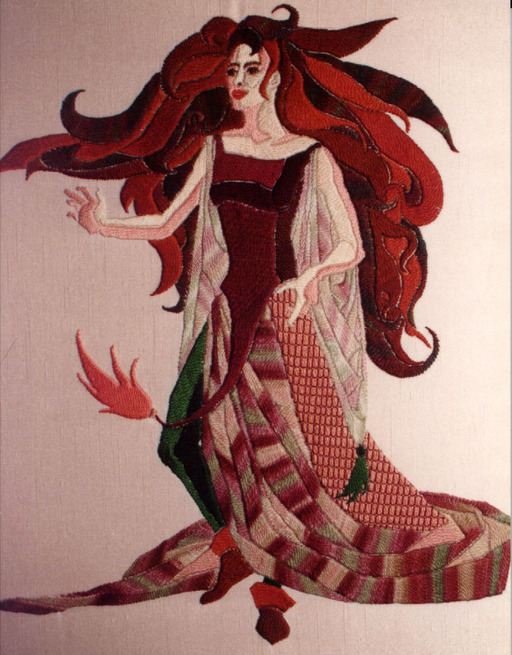Actually, this is the third in a series of pieces I made for my brother. The other two were of war planes. One I put on the back of a shirt; the other on a huge piece of charcoal grey fabric for which I had to construct (or more likely conned my dad into constructing) a custom frame. Unfortunately, I didn't know how to get the fabric taut, and it was so wide I had difficulty reaching the center of the piece. That one I embroidered over painting, with yarns.
The idea behind making the christmas presents was to a) save money and b) put a little more of myself into the project than I felt I could do in selecting an item from list (this is a family tradition) and purchasing it. I have never saved money by making people gifts, and often they're duds besides, which more than the lack of time is the reason I've given up the practice, preferring to incorporate that personal touch in the wrapping instead.
Having wised up a little (I wasn't really in the mood for another warplane) I asked my brother for several subjects. Most of them were probably of the warplane or perhaps automotive category, but one, ‘a lady’ had potential, and so this piece pleased both maker and recipient. There are several influences in this piece: the face, arms, hair, leg, and folded fabrics all show the narrow satin stitch strip technique that dates back to my oldest pieces. The bodice (look closely) has my interpretation of diagonal couching (hippari-osae) and the overskirt a very loose adaptation of lattice couching (goban-osae), which along with the frame and lacing method that stretched the fabric over it, were all techniques to which I was introduced in a beginning traditional Japanese silk embroidery class. Needless to say my un-Japanese habit of asking questions annoyed the teacher to no end, and no doubt my (often deliberately) sloppy technique would horrify the discipline's (and that is the right word) adherents.
I was also continuing my explorations, first shown in the Rejiquar embroidery, of ombre threads and heavier weight perle cottons, the visual texture of which I was beginning to find very appealing. (And the traditional Japanese piece I made in the class? Well, if I ever finish it, I'll put that on the site too. But don't hold your breath. It's been sitting in my closet for well over 5 years, and during the one attempt to start on it again, the need to work consistantly to maintain this level of skill was very forcibly brought home!)

First updated Sun Aug 30 12:49:09 EDT 1998
Japanese Frames don't mess around...(Part II)
Thus, this piece shows the most influence of the only formal embroidery training I've ever had, from Shay Pendray, who teaches traditional Japanese embroidery. It uses special needles (stored in a large wool block, so they don't rust); an awl, called a takeburi, to stroke the threads so they'll lay properly, triangles (for precision) and special, untwisted silk that catches on the rough spots of your skin and tangles if you look at it cross-eyed.
I soon experimented with fancy couching on long satin stitches that are so common in Japanese embroidery techniques, using it here for the woman's overskirt. Unlike western embroidery, which is worked loose or in a hoop, Japanese fabric is tightly laced to a rectangular frame, making a drum-taut fabric that is a pleasure to work on, though the ripping sound the thread makes going through the fabric can be distracting to others sharing the room!
The piece, which my brother requested as a Christmas present, is made with 5 perle cotton, caron overdyed cotton (sleeves, hair), overdyed wool (the underside of the garment, turned up). In addition to the obvious couching on the skirt, there is also the subtle (almost invisible) diagonal couching on her bodice, also a Japanese technique.
Unless otherwise noted, text, image and objects depicted therein copyright 1996--present sylvus tarn.
Sylvus Tarn